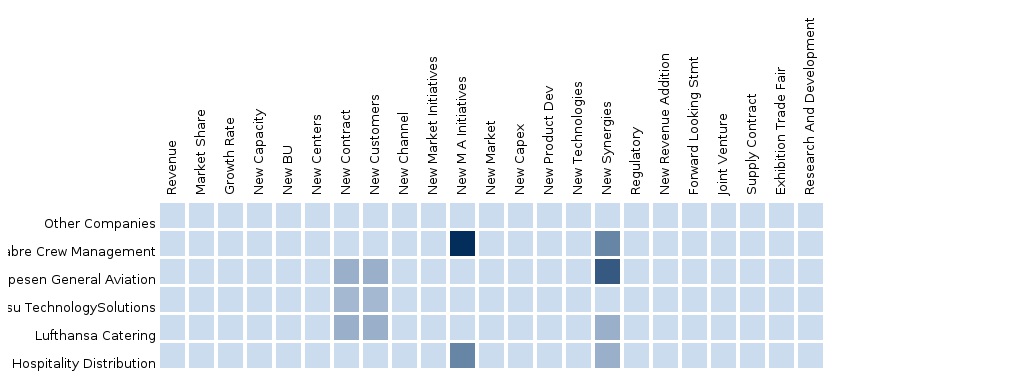The commercial aviation crew management system market in APAC is valued at $409 million and is expected to reach $552 million by 2017. The market in APAC is expected to grow at a CAGR of 11.9% from 2014 to 2017. Crew resource management is an inevitable part in the IT sector of aviation. IT spending in the aviation sector is expected to grow in the future. This report discusses about the underlying market opportunities of crew management systems, latest technology, product variations according to airline fleet size and the major players in the market. The report also deals with the future of CMS and estimates the value of the market for the next five years.
APAC’s commercial aviation crew management system market is segmented on the basis of fleet size, which includes segment A, segment B, and segment C, and by type of crew management system that includes manpower management, crew pairing, crew rostering, and crew management & training.
This report presents a complete analysis of crew management system market in the APAC region across the forecast period. It provides the market value of the APAC commercial aviation crew management system market over the next five years and also discusses about the market shares of the different sub-segments.
It provides insight into the regional trends in spending and analyzes the market value by region and also provides data on spending patterns of the sub-segments in the APAC region. It tracks, analyzes, and lays out the market values of the major spenders on commercial aviation in the APAC region. The major countries which contribute to the global CMS market from APAC include China, India, Japan, and Malaysia.
This report also covers leading competitors in the APAC region who are operating in commercial aviation, and apart from a general overview of the companies, it also provides details on their financial position, key products, and markets. The major industry participants include Sabre Airline Solutions (USA), IBS Software Services (India), Blue One Software (Brussels), Jeppesen (USA), Lufthansa Systems (Germany), and Fujitsu (Japan).
CUSTOMIZATION OFFERINGS:
1.HISTORICAL DATA FOR 5 YEARS
- Financials
- Orders/Deliveries/Backlog data
- Macro indicator data
- M&A data
- Budget and defense program information
2.COMPANY PROFILES
- In-depth analysis of the company’s product portfolio
- Competitive landscape (revenue, operating margin, marginal cost, P/E ratio, EPS, Developments/Deals/Events)
- Ratio analysis
3.SOFTWARE SYSTEMS AND COMPONENT RELATED INFORMATION
4.GLOBAL TRENDS / MARKET ENVIRONMENT
i.Product and technological advancements/latest innovation and development
ii.Demand and supply analysis
iii.Market consolidation (M&A, joint ventures, divestment and spin off)
iv.Air traffic data
v.Export/Import data (Aerospace product and parts)
vi.Industrial production and capacity optimization data
vii.Deliveries and orders
5.PREDICTIVE FORECASTING
- Time series
- Regression analysis
6.PRODUCT ANALYSIS
- Usage pattern (in-depth trend analysis) of products (segment-wise)
- Product matrix, which gives a detailed comparison of product portfolio of each company mapped at country and sub segment level
- End-user adoption rate analysis of the products (segment-wise and country-wise)
- Comprehensive coverage of product approvals, pipeline products and product recalls
7.SUPPLY CHAIN/VENDOR ANALYSIS
Coverage - Vendor analysis, vendor financing, customers/self funding, and distribution network
1 Executive Summary
2 Introduction
2.1 Objective Of The Study
2.2 Market Definition - Commercial Aviations Crew Management System Market
2.3 Evolution Of Cms
2.4 Cms Industry
2.5 Cms Implementation Process
2.6 Market Coverage
2.7 Stakeholders
2.8 Research Methodology
2.8.1 Market Estimation Methodology (Top-Down, Bottom-Up, Data Triangulation)
2.8.2 Market Size
2.8.3 Key Secondary Sources
2.8.4 Key Primary Sources
2.8.5 Macro Indicators
2.9 Assumptions
2.10 Acronyms
3 Market Dynamics
3.1 Drivers And Restraints For The Market
3.1.1 Drivers
3.1.1.1 Improvisation In Operational Planning, By Airlines
3.1.1.2 Passenger Traffic Ratio
3.1.1.3 Demand For Real-Time Crew Monitoring
3.1.1.4 Increased Focus On Productivity Across Fleet
3.1.1.5 Increase In Safety Operations
3.1.2 Restraints
3.1.2.1 Increased Operational Cost
3.1.2.2 Slow Economic Growth
3.1.3 Challenges
3.1.3.1 Changing Technology
3.1.3.2 Fluctuation In Airline Industry
3.1.3.3 Implementation Time
3.1.3.4 System Upgradation
3.2 Auxiliary Factor - Scenario Analysis
3.2.1 Factors Considered For Scenario Analysis
3.2.2 Change In The Passenger Traffic Ratio
3.2.3 Number Of Aircraft Orders
3.2.4 Airline Industry As A Whole
4 Technology Roadmap
4.1 Scalable Cms
4.2 Optimization Of Crew Rosters
4.3 Key Benefits Of Optimizers
4.4 Use Of Ipads And Smart Phones In Cms
4.5 Key Benefits Of Smart Cms
4.6 Real Time Updates On The Flight
5 Commercial Asia-Pacific Crew Management System Market Analysis
5.1 Market Analysis By Types
5.2 Market Analysis By Fleet Size
5.3 Market Analysis By Country
5.4 Market Analysis By Airports
5.4.1 Airports In The Apac Region
5.5 Market Analysis By Airlines
5.5.1 Airlines In The Apac Region
5.6 Market Analysis By Passenger Traffic
5.7 Market Analysis By Aircrafts
5.8 Support Tables
6 Commercial Asia-Pacific Crew Management System: Competitive Landscape
6.1 Developments of Commercial Crew Management Systems: By Companies
7 Apac Commercial Asia-Pacific Crew Management System Market, By Companies
7.1 Sabre Airline Solutions
7.1.1 Introduction
7.1.2 Product Portfolio
7.1.3 Financials
7.2 Jeppesen
7.2.1 Introduction
7.2.2 Product Portfolio
7.2.3 Financials
7.3 Lufthansa Systems
7.3.1 Introduction
7.3.2 Product Portfolio
7.3.3 Financials
7.4 Fujitsu
7.4.1 Introduction
7.4.2 Product Portfolio
7.4.3 Financials
7.5 Ibs Software Service
7.5.1 Introduction
7.5.2 Product Portfolio
7.5.3 Financials

Please fill in the form below to receive a free copy of the Summary of this Report
Please visit http://www.micromarketmonitor.com/custom-research-services.html to specify your custom Research Requirement














